A search for reverse transcriptase-coding sequences reveals new non-LTR retrotransposons in the genome of Drosophila melanogaster
- PMID: 11178266
- PMCID: PMC16141
- DOI: 10.1186/gb-2000-1-6-research0012
A search for reverse transcriptase-coding sequences reveals new non-LTR retrotransposons in the genome of Drosophila melanogaster
Abstract
Background: Non-long terminal repeat (non-LTR) retrotransposons are eukaryotic mobile genetic elements that transpose by reverse transcription of an RNA intermediate. We have performed a systematic search for sequences matching the characteristic reverse transcriptase domain of non-LTR retrotransposons in the sequenced regions of the Drosophila melanogaster genome.
Results: In addition to previously characterized BS, Doc, F, G, I and Jockey elements, we have identified new non-LTR retrotransposons: Waldo, You and JuanDm. Waldo elements are related to mosquito RTI elements. You to the Drosophila I factor, and JuanDm to mosquito Juan-A and Juan-C. Interestingly, all JuanDm elements are highly homogeneous in sequence, suggesting that they are recent components of the Drosophila genome.
Conclusions: The genome of D. melanogaster contains at least ten families of non-site-specific non-LTR retrotransposons representing three distinct clades. Many of these families contain potentially active members. Fine evolutionary analyses must await the more accurate sequences that are expected in the next future.
Figures
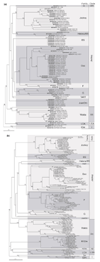
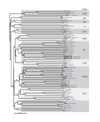

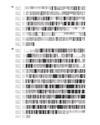
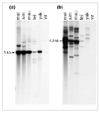

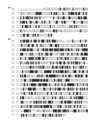
Similar articles
-
Identification of Waldo-A and Waldo-B, two closely related non-LTR retrotransposons in Drosophila.Mol Biol Evol. 2001 Feb;18(2):196-205. doi: 10.1093/oxfordjournals.molbev.a003793. Mol Biol Evol. 2001. PMID: 11158378
-
The non-LTR retrotransposons in Ciona intestinalis: new insights into the evolution of chordate genomes.Genome Biol. 2003;4(11):R73. doi: 10.1186/gb-2003-4-11-r73. Epub 2003 Oct 21. Genome Biol. 2003. PMID: 14611659 Free PMC article.
-
Structural, genomic, and phylogenetic analysis of Lian, a novel family of non-LTR retrotransposons in the yellow fever mosquito, Aedes aegypti.Mol Biol Evol. 1998 Jul;15(7):837-53. doi: 10.1093/oxfordjournals.molbev.a025989. Mol Biol Evol. 1998. PMID: 9656485
-
DIRS-1 and the other tyrosine recombinase retrotransposons.Cytogenet Genome Res. 2005;110(1-4):575-88. doi: 10.1159/000084991. Cytogenet Genome Res. 2005. PMID: 16093711 Review.
-
Mechanisms of LTR-Retroelement Transposition: Lessons from Drosophila melanogaster.Viruses. 2017 Apr 16;9(4):81. doi: 10.3390/v9040081. Viruses. 2017. PMID: 28420154 Free PMC article. Review.
Cited by
-
Getting closer to a pre-vertebrate genome: the non-LTR retrotransposons of Branchiostoma floridae.Int J Biol Sci. 2006;2(2):48-53. doi: 10.7150/ijbs.2.48. Epub 2006 Apr 10. Int J Biol Sci. 2006. PMID: 16733533 Free PMC article.
-
Genome fragment of Wolbachia endosymbiont transferred to X chromosome of host insect.Proc Natl Acad Sci U S A. 2002 Oct 29;99(22):14280-5. doi: 10.1073/pnas.222228199. Epub 2002 Oct 17. Proc Natl Acad Sci U S A. 2002. PMID: 12386340 Free PMC article.
-
Divergent non-LTR retrotransposon lineages from the genomes of scorpions (Arachnida: Scorpiones).Mol Genet Genomics. 2006 Mar;275(3):288-96. doi: 10.1007/s00438-005-0079-3. Epub 2005 Dec 3. Mol Genet Genomics. 2006. PMID: 16328371
-
In vivo RNA localization of I factor, a non-LTR retrotransposon, requires a cis-acting signal in ORF2 and ORF1 protein.Nucleic Acids Res. 2005 Feb 1;33(2):776-85. doi: 10.1093/nar/gki221. Print 2005. Nucleic Acids Res. 2005. PMID: 15687386 Free PMC article.
-
Fosmid library end sequencing reveals a rarely known genome structure of marine shrimp Penaeus monodon.BMC Genomics. 2011 May 17;12:242. doi: 10.1186/1471-2164-12-242. BMC Genomics. 2011. PMID: 21575266 Free PMC article.
References
-
- Eickbush TH. Transposing without ends: the non-LTR retrotransposable elements. New Biol. 1992;4:430–440. - PubMed
-
- Malik HS, Burke WD, Eickbush TH. The age and evolution of non-LTR retrotransposable elements. Mol Biol Evol. 1999;16:793–805. - PubMed
-
- Jakubczak JL, Xiong Y, Eickbush TH. Type I (R1) and type II (R2) ribosomal DNA insertions of Drosophila melanogaster are retrotransposable elements closely related to those of Bombyx mori. J Mol Biol. 1990;212:37–52. - PubMed
-
- Xiong YE, Eickbush TH. Functional expression of a sequence-specific endonuclease encoded by the retrotransposon R2Bm. Cell. 1988;55:235–246. - PubMed
Publication types
MeSH terms
Substances
LinkOut - more resources
Full Text Sources
Molecular Biology Databases

